- TEA ROOM -
The tea room of null² incorporates the concepts of traditional Japanese tea spirit and mandala-like space. The entire architecture is connected to the tea-like spirituality and Japanese aesthetics, redefining them in the context of digital nature civilization. In reference to Osaka, a golden robotic arm inspired by the Golden Tea Room moves the membrane, creating a symbolic exhibition where tradition and technology intersect.
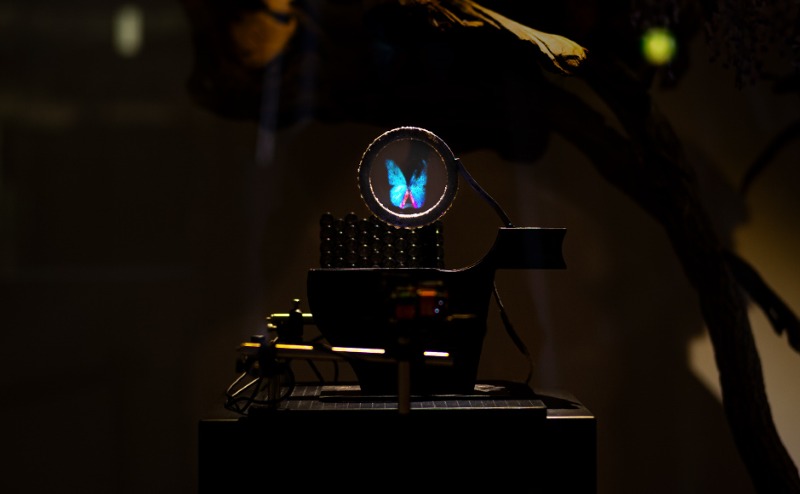
Colloidal Display
2012
3D printed structure, Iron, Laser, Driving Circuit, Wood
This work continues the artist's exploration of the relationship between material and image. The ethereal images that dimly appear on the soap film's surface are created through ultrasonic vibrations that agitate the transparent thin film, combined with the light from a projector. This is a material yet imperfect image of a butterfly that glows organically. Transparent thin films like soap bubbles cannot normally project images because they transmit light. Here, ultrasonic waves rapidly diffuse the light. This work exists at the intersection of material fragility—disappearing at the slightest touch—and the unique condition where ultrasonic vibration and light meet on a film less than one micrometer thin. The piece reconsiders video as a medium of sound and light, pursuing more material-based image expressions. It is a medium that spans between reflection and light, low and high resolution, liquid and solid, transparency and diffusion, material and image. The aesthetic sensibilities of yūgen (profound grace) and sansuimei (mountain-water clarity). Our media consciousness that finds beauty in the gap between the subtle and the certain, between high and low resolution, has continued since the mid-Heian period. We desire vivid expressions created from ephemeral materials.
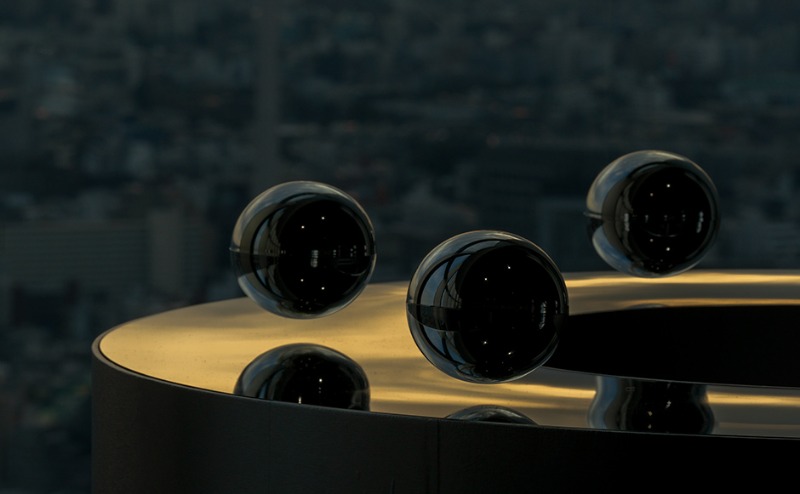
Levitrope
2016
3D printed structure, Driving Circuit, Motor, Film, Wood
Levitation is a mystical phenomenon. The act of suspending matter in midair under the force of gravity evokes a departure from the natural order. For this reason, levitation has been incorporated into numerous illusions and magical performances, captivating audiences with its enigma. On a stage, levitation may appear as the magician's arcane power—but when no human intervention is perceived, levitation forcibly reminds the viewer of their own corporeality. This is because the contrast between the viewer's body bound by gravity and an object freed from it reflexively intensifies awareness of one's own body. "Levitrope," a media apparatus named from the coined term derived from "lev(itation)" and "trope (rotation)," is a device where a metallic sphere is magnetically suspended and continuously rotates like a wheel, capturing its surrounding landscape upon its spherical surface. In the age of Edison, rotating images allowed humans to successfully extract a substantial world from nature. Through this device that continuously rotates an appearance containing physical substance, I wish to consider media installations in the age of digital nature. When the sense of levitation's unreality disappears, only the video-like appearance remains. The high-resolution brilliance emitted by the mirror, the beauty of diffused light in the low-resolution sky and clouds reflected in it—this anti-gravitational moving mirror sculpture cuts out the sansuimei (mountain-water clarity) landscape, a technium of mirrors that extracts the scenery.

Borrowed Scenery and Materialized Waves #6
2018
3D printed structure, Magnet, Electromagnet, Microcontroller
This work captures and transposes the surrounding landscape, undergoing perpetual transformation akin to a mani wheel (prayer wheel). Within the present pavilion, this motif is conceptually and materially extended into multiple forms—including the entire pavilion structure (null²), Re-Materialization Waves "Silver Mouse Fish", the "Sword of Null," and "Woodized Waves - mirror -". Each instance articulates a different phase of metamorphosis, embodying a recursive reflection on digital reincarnation and material fluidity within digital nature.
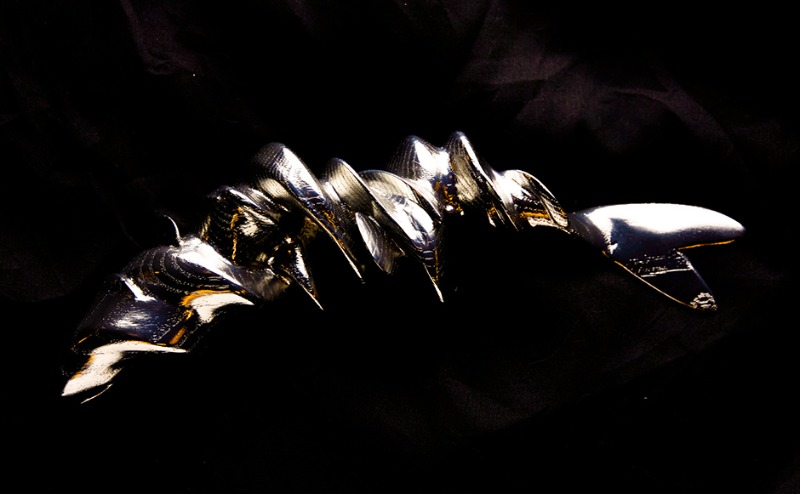
Re-Materialization Waves "Silver Mouse Fish III"
2022
Silver paint on chestnut wood
This work was created in collaboration with Shinjiro Ito, a highly skilled woodworking artisan based in Takayama, renowned for his mastery in intricate manual craftsmanship. The prototype was produced through the cooperation of Karimoku Furniture, which milled the wooden form based on 3D data provided by the artist. Yoichi Ochiai envisions a levitating silver sculpture that transforms the landscape while reducing space to musical periodicity. The aspiration toward a digital nature—where the dialectic between mass and immateriality is resolved through the transmutation of image and substance, wave and matter, intelligence and vibration—seems largely driven by the artist's desire to become one with the landscape and space through the synesthetic experience of sound and light. This particular piece visualizes the process of transforming gin-kou-gyo (silver-mouthed sweetfish, or ayu) into a three-dimensional wave form. Ayu, living in clear streams and feeding on river algae, vary in taste depending on their native rivers, truly embodying the complexity of their local environments. Deeply embedded in Japanese classical traditions, ayu appear in the Nihon Shoki (Chronicles of Japan) where Empress Jingū divined the outcome of a battle by catching an ayu with a fishing hook cast into a river. The sun goddess Amaterasu is often identified with Vairocana Buddha. The representation of the ever-changing nature of all things resembles motifs of mirrors and water surfaces. The wooden sculpture, born from a journey interweaving the ayu, mythology, mirrors, and the context of digital reincarnation as a transformative motif, exists as a material entity between wave and living being. Created through the combination of CNC-milled 3D data and Ito's artisanal skill, it floats within the mass-bearing natural world as an intermediary substance between wave and creature.
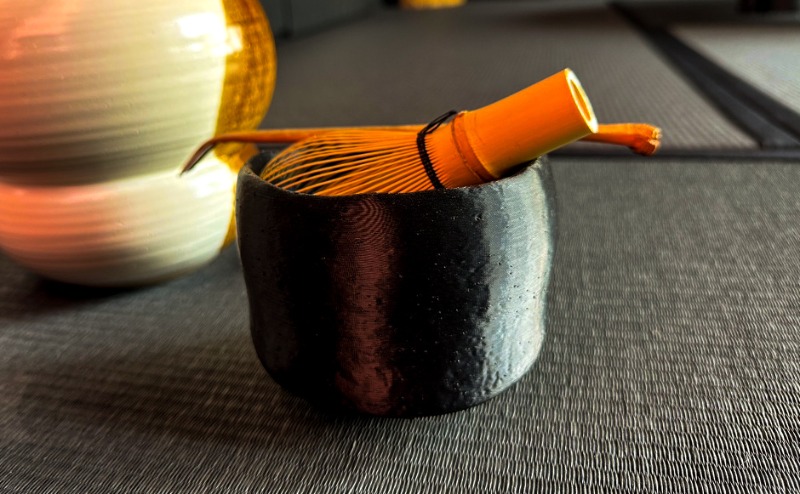
Pla-Raku
2019
3D printed structure
This is a 3D-printed replica of a raku tea bowl created for the Pla-An (可塑庵) tea hut. It is originally a copy of a metal tea bowl made for the exhibition "Digitally Natural, Naturally Digital" (2019) at the National Museum of Emerging Science and Innovation (Miraikan). It is said that a raku tea bowl is a disappearing bowl. It forms a contrasting structure with this pavilion and tea room that dissolve and disappear into the landscape, as the raku bowl becomes familiar to the hand and gradually disappears. The interior presentation signifying the immediate present and the concept of "one is all, all is one" run through this pavilion.
Cooperation: Raku Kichizaemon (16th Raku Family Head), Miraikan - The National Museum of Emerging Science and Innovation
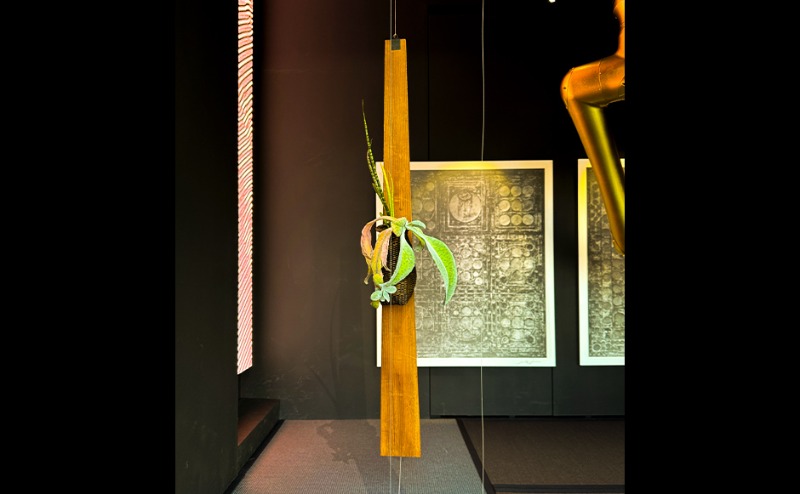
Herbaceous Composition
2025
Arranger: Photographer and Practitioner of the Way of Flowers, Senshu Ikenobo
Organic and Digital elements occupying the same space, and therein lies a faint but
certain
ebb and flow of life. The Kalanchoe and Sansevieria are both plants that grew near
me and
have been influenced by the places they grew and by the people there. For the next
184
days they will feel the passing of the sun in this new place. Here is a collection
of
moments
where heaven and earth connect, water flows and cycles, and buds quietly sprout and
grow.
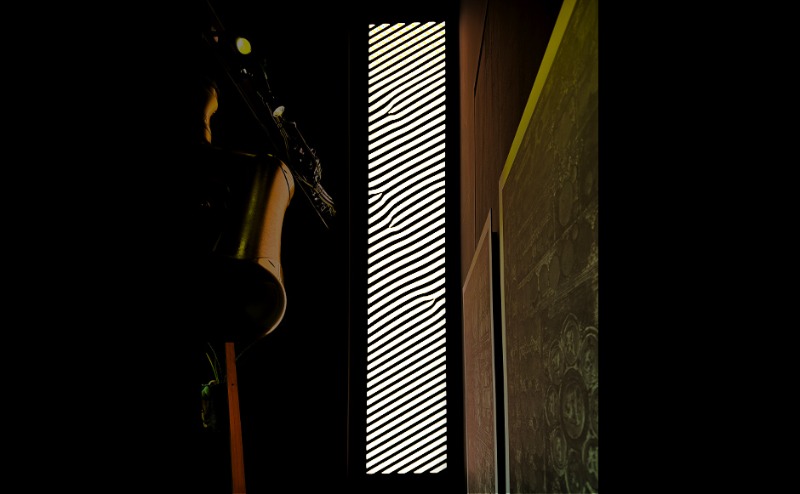
Liquid Universe ∽ Phantom Resonance ∽ MatagiDrive
2025
LED vision, Generative AI
《Liquid Universe∽Phantom Resonance∽Matagi Drive》 is an installation where, in the fluid phase of digital nature, humans temporarily release their nature as symbol-manipulating animals and, while enveloped in the resonance of generative AI (Phantom Resonance), experience and collect information non-verbally and in a hunter-gatherer manner (Matagi Drive). The constantly generated and transforming visual expression (Liquid Universe) dissolves the boundaries of "self" and invites viewers into the flow of all things. The audience is immersed in an improvisational poetics of light and sound woven by the digital and natural, exploring new connections with the immaterial world shown by computers. This is not just interaction, but participation in an evolving cosmology.
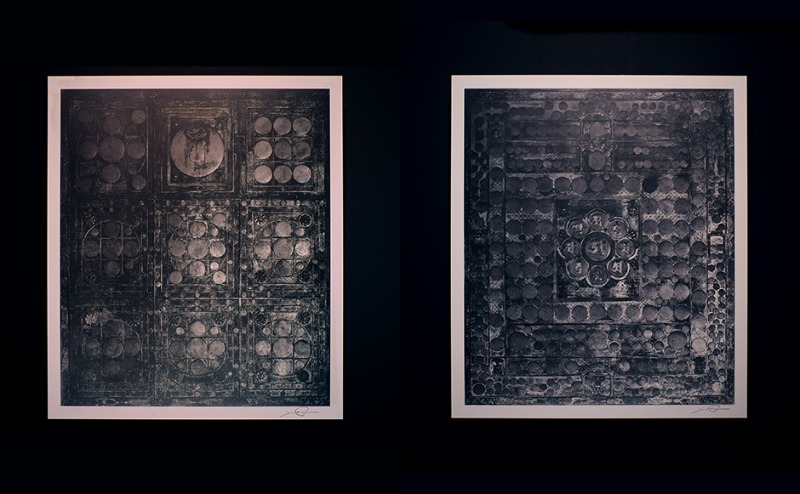
Imaging Mandala Study V
Imaging Mandala Study VI
2021
Platinum Palladium Print, Aluminum Composite Material
This piece is created by combining high-resolution digital imaging with classical platinum palladium print techniques, depicting the 13th-century Gilt Bronze Womb World Mandala housed in Daigoji Temple. Employing the conceptual framework of digital nature, the mandala's esoteric cosmology is successively translated and restructured into a contemporary visual language, enabling a unique perceptual experience. The work integrates object-oriented philosophy, dissolving borders between past and future, reality and virtuality, digital and nature—creating a world unique to Yoichi Ochiai. This piece is hand-printed by Yoichi Ochiai himself. Through the nostalgic symbol of a rotary-dial telephone, it evokes a multidimensional resonance between past and present, matter and non-matter, humans and digital nature. Like an object-oriented bodhisattva, each element engages in dialogue through the inherent, effortless memory within each object and the collective memories of people from the past, aiming to revive the spirit of mingei (folk craft) within the digital context. Through works that interact with large language models, one can experience how the existence of language models spins out words like the Alaya-vijnana (storehouse consciousness). Phantom Resonance embodies the reinterpretation of how human knowledge accumulated throughout history has resonated to create yokai (supernatural entities) and mythology, now reimagined through modern computational technology.
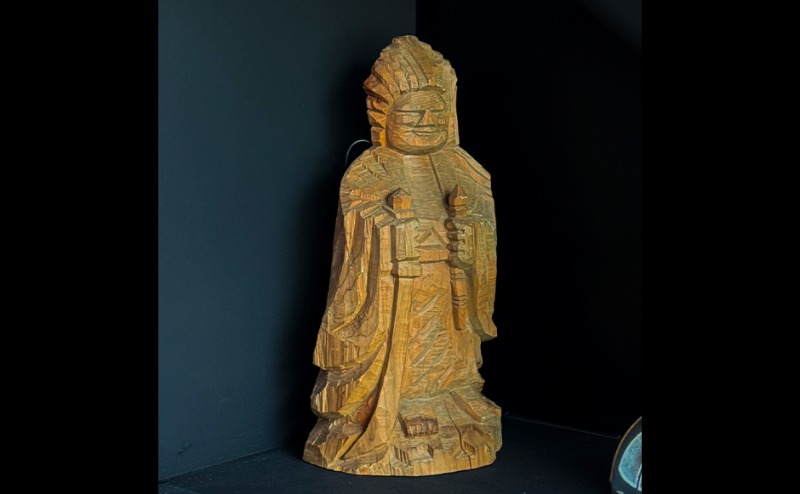
Souls Distilled into Forms ∽ Time-Space XI (Enkū synthesizer Ⅺ)
2024
Wood, Circuit Board, Speaker
This series fuses Enkū Buddha statues with modular synthesizers. The spirituality of Enkū's Buddhist sculptures and modern electronic music technology unite to bring new resonance to the space. Viewers can experience the blurring boundaries between material and immaterial, tradition and cutting-edge technology, human and machine. It explores the forms of ontology and beauty in digital nature, creating a space where past and future intersect. The sonic and visual expressions—emerging from CRTs and modular synthesis—recall the meditative force of carved wood, channeled through contemporary frequencies.